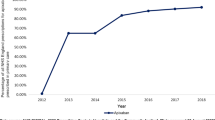Summary
In the US, managed-care organisations (MCOs) have turned to pharmacy benefit management (PBM) companies to contain costs and provide total disease management packages. The demand for pharmacoeconomic research and information by purchasers of healthcare has contributed to the growth of PBM companies and to recent acquisitions by pharmaceutical manufacturers. PBMs influence prescribing via formulary management and drug utilisation review (DUR). Formularies are generally open, and pharmacoeconomic data contribute to formulary management decisions. Prospective and concurrent DURs used in hospitals can soon be integrated into community pharmacy, as PBMs obtain integrated online information about prescribing. PBM prescription databases are used as as educational tools for physicians, providing drug utilisation data, formulary compliance, generic prescribing rates, and guidelines for pharmacotherapy for particular conditions. They can also evaluate medication regimens for patients with particular problems such as drug-drug interactions. However, PBM databases typically lack patient diagnostic, outcome and medical claim data. PBMs will be better placed to move from medication management to disease management when they can obtain these data and link them appropriately to their own prescribing and physician databases.
Similar content being viewed by others
References
Anon. Market Letter 18 July 1994; 3
The expanding role of PBMs. Business and Health (Special report) 1995; 3: 6–11
Kreling DH, Mott DA. The cost-effectiveness of drug utilisation review in an outpatient setting. PharmacoEconomics 1993; 4(6): 414–36
Stolar MH. Drug use review: operational definitions. Am J Hosp Pharm 1978; 35: 76–8
American Society of Hospital Pharmacists. ASHP statement on the formulary system. Am J Hosp Pharm 1986; 43: 2839–42
Pearce MJ, Begg EJ. A review of limited lists and formularies; are they cost effective? PharmacoEconomics 1992; 1(3): 191–202
Gray M. Whither PBMs? Pharmaceutical Times Feb 1995; 29
Lipsy RJ. Institutional formularies. The relevance of pharmacoeconomic analysis to formulary decisions. PharmacoEconomics 1992; 1(4): 265–81
Nash D, Catalano ML, Wordell CJ. The formulary decision making process in a US academic medical centre. PharmacoEconomics 1993; 3(1): 22–35
Garattini S, Tognoni G. Drug utilisation review and pharmacoeconomics: interaction after parallel development? PharmacoEconomics 1993; 4(3): 162–72
Soumerai SB, McLaughlin TJ, Ross-Degnan D, et al. Effects of a limit on Medicaid drug reimbursement benefits on the use of psychotropic agents and acute mental health services by patients with schizophrenia. N Eng J Med 1994; 331: 650–5
Anon. The EDI revolution. Business and Health (Special report) 1995; 13 (No. 3) Suppl. B: 22–4
Glass H. Quality of life and formularies. Scrip Magazine 1995; 38: 45–7
Anon. Which diseases are appropriate for disease management? PharmacoResources 27 May 1995; 29: 15
Greineder DK, Loane KC, Parks P. Reduction in resource utilisation by an asthma outreach program. Arch Pediatr Adolesc Med 1995; 149: 415–20
National Asthma Education and Prevention Program. Role of the pharmacist in improving asthma care. Am J Health-Systems Pharmacy 1995; 52: 1411–16
Anon. Pharmacy risk-sharing promotes saving. Business and Health (Special report) 1995; 13 (No. 3) Suppl. B: 18–21
Anon. Health care reform. Business and Health (Special report) 1995; 13 (No. 3) Suppl. C: 9
Barry MJ, Fowler FJ, Mulley AG, et al. Patient reactions to a program designed to facilitate patient participation in treatment decisions for benign prostatic hyperplasia. Med Care 1995; 33: 771–82
Author information
Authors and Affiliations
Rights and permissions
About this article
Cite this article
Thomas, N. The Role of Pharmacoeconomics in Disease Management. Pharmacoeconomics 9 (Suppl 1), 9–15 (1996). https://doi.org/10.2165/00019053-199600091-00004
Published:
Issue Date:
DOI: https://doi.org/10.2165/00019053-199600091-00004




